In Silicon Valley, venture capitalists always want to know: "What is your value proposition?"
In plain English: they want an explanation why an end-user would pay money for your product.
Here, we'll make the case for the CTNS Certification Package with three different propositions, showing the huge value you get for a small cost ... and why you should register today for this package.
Value Proposition 1: Certification
Value Proposition 2: The Knowledge You Will Gain
Value Proposition 3: Course Quality and Instructor Quality
| CTNS Certification Package Value Proposition (1): Certification |
| And it's backed up with not only a Certificate, but also a personalized Letter of Reference / Letter of Introduction explaining your knowledge and inviting the reader to contact Teracom for verification. |
| Certification also has significant value for employers - an extremely cost-effective way of implementing consistent, comprehensive telecommunications and networking technology fundamentals training, ensuring that existing resources and new hires are up to the same speed, with a common vocabulary, framework and knowledge base... with proof of results. |
| That's a LOT of value in proving your knowledge! |
| CTNS Certification Package Value Proposition (2): What You Will Learn |
| The CNTS Certification Package is Teracom's famous core telecom training, online, with certification. |
| The second value you get with this package is what you will learn; the knowledge and skills you will acquire. Here's what you will be able to do after taking the six courses in the Certified Telecommunications Network Specialist package: |
|
Course 2201 The PSTN Loops and Trunks • POTS • Circuit-Switching • LECs, CLECs and IXCs • Analog • Voiceband • DTMF • SS7 One cornerstone of a full, rounded base of knowledge of telecommunications is the structure and operation of the Public Switched Telephone Network, built over the past 135 years, still in operation in every country on earth – knowledge necessary for connecting the PSTN to, and steadily replacing the PSTN with IP telecom technologies. In this course, you'll build a solid understanding of the fundamentals of the telephone system: Customer Premise and Central Office, loops, trunks, remotes, circuit switching and how a telephone call is connected end-to-end. We'll cover LECs, CLECs and IXCs, sound, analog and the voiceband, twisted pair, DTMF and SS7. Updated for the 2020s. Course Lessons Based on Teracom's famous Course 101, tuned and refined over the course of more than 20 years of instructor-led training, we'll cut through the jargon to demystify telephony and the telephone system, explaining the jargon and buzzwords, the underlying ideas, and how it all works together… in plain English. Featuring many photos of actual equipment both inside a Central Office and in the outside plant, this multimedia course is an excellent way to get up to speed on traditional telephony. In this online telecommunications course, we begin with a history lesson, understanding how and why telephone networks and the companies that provide them are organized into local access and inter-city transmission, or as we will see, Local Exchange Carriers (LECs) and Inter-Exchange Carriers (IXCs). Then we will establish a basic model for the PSTN and understand its main components: Customer Premise, Central Office, loop, trunk, outside plant, circuit switching, attenuation, loop length, remotes, and why knowledge of the characteristics of the loop remains essential knowledge even though we are moving to Voice over IP. Next, we'll cover aspects of telephony and Plain Ordinary Telephone Service, including analog, the voiceband, twisted pair, supervision and signaling including DTMF. The course is completed with an overview of SS7, the control system for the telephone network in the US and Canada. On completion of this telecommunications course online, you will be able to draw a model of the Public Switched Telephone Network, explain its core-and-edge architecture, identify components and technologies, along with the big picture, including:
Detailed Course Outline 1. Introduction Course introduction and overview 2. History of Telecommunications Local phone companies, long distance; US: Bell System, breakup, LECs and IXCs; Canada 3. The Public Switched Telephone Network (PSTN) Loops and trunks, CO, customer premise, circuit-switching, outside plant, loop length, remotes 4. Analog Circuits and Sound What analog means, microphones and speakers, copper wires and electricity, trees falling in the forest 5. The Voiceband Reproducing thoughts vs. reproducing sound, frequency range, filters, limitations 6. Plain Ordinary Telephone Service (POTS) Twisted pair, analogs on two wires, dial tone, ringing, supervision, lightning protection 7. Signaling: Pulse Dialing and DTMF Dial-up, make-or-break signaling, touch-tone, DTMF, in-band signaling 8. Signaling System 7 (SS7) Control system for the PSTN, SCPs and SSPs, call routing between carriers Download the Course Brochure PDF for the full detailed description Individual Course Certified Telecommunications Network Specialist (CTNS) Certification Package Certified Telecommunications Analyst (CTA) Certification Package CTSME: Certified Telecommunications Subject Matter Expert certification package includes this course. Shop with confidence! All choices come with a 100% Money-Back Guarantee: full refund within 30 days. details Course 2206 Wireless Telecommunications Mobile Network Fundamentals • Cellular Principles • Digitized Voice over Radio • Mobile Internet • FDMA, TDMA, CDMA and OFDM • 4G LTE and OFDMA • 5G: New Spectrum, Ultra-Broadband and IoT • Wi-Fi 6 802.11ax • Communication Satellites Wireless Telecommunications is a comprehensive up-to-date course on cellular plus Wi-Fi and satellites. Taking this course, you will develop a solid understanding of the fundamental principles of radio, mobility and cellular; network components and operation, digital radio, mobile phone calls and mobile Internet access; and spectrum-sharing technology OFDM, and how it's used in LTE and 5G. In addition, you will get up to speed on the components, operation and latest standards for Wi-Fi, and the essentials of satellite communications. Course Lessons
We'll cut through the jargon to demystify wireless, explaining the fundamentals of cellular and mobility, the buzzwords, the network, technologies and generations, the underlying ideas, and how it all works together... in plain English. You'll gain a solid understanding of the key principles of wireless and mobile networks:
We begin with basic concepts and terminology involved in mobile networks, including base stations and transceivers, mobile switches and backhaul, handoffs, cellular radio concepts and digital radio concepts. You'll understand how a phone call connects from a cell phone to a landline, and the different methods of allowing other devices to use a smartphone's mobile Internet connection. Without bogging down on details, we'll review spectrum-sharing technologies: FDMA for first generation; 2G GSM/TDMA, 3G CDMA and 4G and 5G OFDM. We'll take some time to understand how modems represent bits on subcarriers, and how OFDMA is used in 4G and 5G to dynamically assign subcarrier(s) to users. This is followed with Wi-Fi, or more precisely, 802.11 wireless LANs: the system components, frequency bands, bitrates and coverage for all of the versions up to Wi-Fi 6 which is 802.11ax, the first Wi-Fi to implement full-duplex communications with multiple simultaneous devices using OFDMA and a theoretical 9.6 Gb/s. We'll also cover WPA-2 and WPA-3 security. The course is completed with communications satellites, in Geosynchronous Earth Orbit and Low Earth Orbit, including Iridium Next and Starlink. Detailed Course Outline 1. Introduction Course introduction and overview. Basic radio principles, analog and digital over radio. 2. Mobile Network Components, Jargon and Operation Handset, base station, airlink, handoffs, backhaul and connection to wireline systems 3. Cellular Principles The requirements of coverage, capacity and mobility. Cellular for coverage, spectrum sharing for capacity, and handoffs for mobility. 4. PSTN Calls Using the Native Phone App: "Voice Minutes" Components and operation involved in a phone call: microphone, codec, RF modem, antenna, backhaul and connection to other carriers at the Toll Center building. 5. Mobile Internet: "Data Plan" Mobile Internet via a smartphone; using the RF modem and antenna as a tethered modem, mobile Wi-Fi hotspot. 6. Spectrum-Sharing: FDMA, TDMA, CDMA, OFDM Sorting out the generations and standards. 7. 4G LTE: Mobile Broadband Subcarriers, how LTE implements modems on subcarriers, and OFDMA for dynamic capacity sharing. 8. 5G NR: Enhanced Mobile Broadband, IoT Communications New spectrum and use cases: more b/s at conventional frequencies, ultra-broadband in millimeter-wave bands, and low bit rates for IoT devices. 9. Wi-Fi: 802.11 Wireless LANs Wi-Fi components and principles of operation, 802.11 standards, frequency bands and coverage, including Wi-Fi 6 802.11ax, implementing OFDMA with massive performance increase. Completed with WPA-2 and WPA-3 Wi-Fi security. 10. Communication Satellites Geosynchronous Earth Orbit and Low Earth Orbit, Iridium Next and Starlink. Download the Course Brochure PDF for the full detailed description Individual Course Certified Telecommunications Network Specialist (CTNS) Certification Package Certified Telecommunications Analyst (CTA) Certification Package CTSME: Certified Telecommunications Subject Matter Expert certification package includes this course. Shop with confidence! Course 2212 The OSI Layers and Protocol Stacks Protocols & Standards • OSI Model • Layers • Protocol Stacks • FedEx Analogy This course begins the "IP courses" in the Certified Telecommunications Network Specialist (CTNS) certification package. The OSI 7-Layer Reference Model is used to sort out the many functions that need to be performed, to be able to discuss separate issues separately. The functions are organized into groups called layers, which are stacked one on top of the other. This allows us to relate different pieces of the puzzle in subsequent lessons. The course starts with the big picture, then one lesson for each layer, then protocol stacks. Course Lessons
Based on Teracom's famous Course 101, tuned and refined over the course of more than 25 years of instructor-led training. You'll learn what a layer is, what the layers are, what each one does and examples of where things like TCP fit into the model ...and how it all works together… in plain English. This course establishes a framework for all of the discussions in subsequent lessons and courses: the OSI 7-Layer Reference Model, which identifies and divides the functions to be performed into groups called layers. You'll learn what a layer is, the purpose of each layer, see examples of protocols used to implement each layer, and learn how a protocol stack really works with the famous "FedEx Analogy" presented as an embedded video by our top instructor, Eric Coll. On completion of this course, you will be able to explain:
Detailed Course Outline 1. Introduction Course introduction and overview 2. Open Systems Open systems vs. proprietary systems. 3. Protocols and Standards Illustrated overview of all the functions required for communications, and protocols vs. standards 4. ISO OSI 7-Layer Reference Model Top-level overview and introduction to Layers 5. The Physical Layer Fiber, Twisted Pair, Cable and Wireless 6. Data Link Layer LANs and MAC Addresses 7. Network Layer IP, MPLS, Packets and Routers 8. Transport Layer Reliability, Connections, Ports and Sockets 9. Session Layer SIP, POP and HTTP 10. Presentation Layer ASCII, MIME, Compression, Encryption, Codecs 11. Application Layer SMTP, HTML and English 12. Protocol Stacks How a protocol stack and peer protocols actually work. Tracing the flow through the stack with the FedEx Analogy 13. Protocol Headers Babushka Dolls 14. Standards Organizations ISO, IETF, ITU Download the Course Brochure PDF for the full detailed description Build structured, broad knowledge of networks - understanding that lasts a lifetime. Stand out from the crowd! Individual Course Certified Telecommunications Network Specialist (CTNS) Certification Package Certified Telecommunications Analyst (CTA) Certification Package CTSME: Certified Telecommunications Subject Matter Expert certification package includes this course.
Certified IP Telecom Network Specialist (CIPTS) Certification Package
Shop with confidence! Free Lesson 1: Course Introduction Another free lesson: Course 2211 LANs, VLANs, Wireless and Optical Ethernet MAC Addresses • MAC Frames • Layer 2 Switches • VLANs • Ethernet on Copper • 1000BASE-T • Power over Ethernet • Cable Categories • Office Wiring Plan • Wireless Ethernet (Wi-Fi) • Optical Ethernet • Ethernet in the Core, MANs and PONs • Fiber Types • SFP Transceivers • Field Installation This course is all about Ethernet: the fundamentals, equipment and implementations, including twisted-pair copper cables, wireless and optical, in‑building, in the network core, in MANs and PONs. Course Lessons Based on Teracom's famous Course 101, tuned and refined over the course of more than 25 years and counting of instructor-led training. We'll cut through the jargon to demystify Ethernet, MAC addresses, LANs and VLANs, Ethernet on copper wires, Ethernet over the Ether (Wi-Fi) and Ethernet on fiber: Optical Ethernet. You'll understand the jargon and buzzwords, the underlying ideas, and how it all works together to form the physical basis of the network that used to be called the Public Switched Telephone Network (PSTN), now being absorbed Pac-Man style by The Internet, becoming the IP Packet-Switched Telecommunications Network (IP‑PSTN). … in plain English. This course is all about Ethernet: the fundamentals, equipment and implementations including twisted-pair copper cables, wireless and fiber, in-building, in the network core, MANs and PONs. Ethernet implements the equivalent of pipe physically connecting two devices. IP and MPLS are used to move packets from one pipe to another. They are covered in other courses. Ethernet and its MAC frames has fulfilled one of the Holy Grails of telecom, packaging everything the same way on all kind of links: copper wire, fiber and wireless - in the core of the network, in the access network, and in the customer premise. Standardizing on MAC frames across the board makes interworking simpler, more reliable and cheaper to implement. One can only stand back in awe and admire. We'll begin with the fundamental idea of a broadcast domain, first implemented with a bus cable. We'll understand LAN interfaces, and how each interface has a hard-coded MAC addresses, and how the address field in a MAC frame is used to indicate for whom a frame is intended, since all stations in a broadcast domain receive it. We'll then understand how the bus is now inside a box called an Ethernet switch, LAN switch or Layer 2 switch, how the switch learns the MAC address of each station, and how the LAN switch forwards MAC frames to one or more stations. Then we'll go over the important idea of VLANs, which are broadcast domains defined in software, and how VLANs can be used to segregate traffic by device type and by work area at the enterprise level, and segregate traffic by customer at the carrier level. You'll learn about the many standards for implementing Ethernet, 802.3 from the original 10BASE-5 to 1000BASE-T on Categories of twisted-pair cables, 802.11 wireless LANs and Wi-Fi certification. We'll finish with a compressive lesson on Optical Ethernet: Ethernet on fiber, which is the basis of today's telecom network. You'll learn how bits are represented on fiber, how fiber cables are installed underground, and how fiber splicing is used to connect bulk fiber to equipment. We'll review Optical Ethernet standards from 1 Gb/s to 100 Gb/s.
On completion of this course, you will be able to explain:
Detailed Course Outline 1. Course Introduction 2. Broadcast Domains, MAC Addresses and MAC Frames 3. LAN Switches a.k.a. Layer 2 Switches 4. VLANs 5. 802 Physical Standards: 802.3 Twisted Pair and 802.11 Wi-Fi 6. Twisted-Pair LAN Cables, Categories, Wiring Plan and Switch Hierarchy
Wiring 7. Optical Ethernet and Fiber Links Download the Course Brochure PDF for the full detailed description Individual Course Certified Telecommunications Network Specialist (CTNS) Certification Package Certified Telecommunications Analyst (CTA) Certification Package CTSME: Certified Telecommunications Subject Matter Expert certification package includes this course.
Certified IP Telecom Network Specialist (CIPTS) Certification Package
Shop with confidence! Course 2213 IP Networks, Routers and Addresses IP Addresses • Packets • Networks • Routers • Static and Dynamic Addresses • DHCP • Public and Private Addresses • NAT • IPv6 IP Networks, Routers and Addresses is a comprehensive course on IP networking fundamentals: IP packets, IP addressing and IP routers. We'll see how routers implement the network with packet-switching, that is, relaying packets from one circuit to another, and how routers are a point of control for network security. We'll introduce the term Customer Edge (CE), and understand the basic structure and content of a routing table. Then we'll cover the many aspects of IP addressing: IPv4 address classes, dotted decimal, static vs. dynamic addresses, DHCP, public vs. private addresses, Network Address Translation, and finish with an overview of IPv6. Course Lessons
Based on Teracom's famous Course 101, tuned and refined over the course of 20 years of instructor-led training, we'll cut through the jargon to clearly explain IP and routers, packets and addresses, the underlying ideas, and how it all works together… in plain English. This course could also be called "Layer 3", as it is all about Layer 3 of the OSI model: the network layer, and in particular, IP packet networks. Packet networks embody two main ideas: bandwidth on demand and packet switching. First, we'll recap channelized TDM and its limitations, then understand statistical TDM or bandwidth on demand. Next, we'll understand how routers implement the network with packet switching, that is, relaying packets from one circuit to another, and how routers are a point of control for network security. We'll introduce the term Customer Edge (CE), and understand the basic structure and content of a routing table. Then we'll cover the many aspects of IP addressing – needed to be able to do the packet switching: IPv4 address classes, dotted decimal notation, static vs. dynamic addresses, DHCP, public vs. private addresses, Network Address Translation, and finish with an overview of IPv6 and IPv6 address allocation and assignment.
On completion of this course, you will be able to explain:
Detailed Course Outline 1. Introduction Course introduction and overview 2. Review: Channelized Time-Division Multiplexing (TDM) Traditional TDM – and why it is inefficient 3. Statistical Time-Division Multiplexing: Bandwidth-on-Demand Overbooking and opportunistic capacity 4. Private Network: Bandwidth on Demand + Routing The simplest framework for understanding routers and bandwidth on demand 5. Routers Routers and routing tables. Packet forwarding and packet filtering. Customer Edge. 6. IPv4 Addresses Address classes and dotted-decimal notation. 7. DHCP Dynamic addresses and static addresses – and how both are assigned using DHCP 8. Public and Private IPv4 Addresses How to obtain public addresses, and why private addresses are used in many cases 9. Network Address Translation How a NAT glues private IPv4 addressing used in-building to public addressing used on the Internet 10. IPv6 Overview Introduction to IPv6, what's new, the improvements on IPv4 and the IPv6 packet format 11. IPv6 Address Allocations and Assignment Types of IPv6 addresses, registries and allocations to ISPs. How subnets are assigned to end-users Download the Course Brochure PDF for the full detailed description Understand the whole IP story, including routers, packets, addresses, DHCP, NAT and IPv6. What's not to like? Individual Course Certified Telecommunications Network Specialist (CTNS) Certification Package Certified Telecommunications Analyst (CTA) Certification Package CTSME: Certified Telecommunications Subject Matter Expert certification package includes this course.
Certified IP Telecom Network Specialist (CIPTS) Certification Package
Shop with confidence! Course 2214 MPLS and Carrier Networks Carrier Packet Networks • Technologies • MPLS • MPLS VPNs • SLAs • CoS • Integration & Aggregation MPLS and Carrier Networks is a comprehensive training course designed to build a solid understanding of carrier packet networks and services, the terminology, technologies, configuration, operation and most importantly, the underlying ideas… in plain English. We'll cut through the buzzwords and marketing to demystify carrier packet networks and services, explaining Service Level Agreements, traffic profiles, virtual circuits, QoS, Class of Service, Differentiated Services, integration, convergence and aggregation, MPLS and other network technologies, and how they relate to TCP/IP, without bogging down on details. Course Lessons Based on Teracom's famous Course 101, tuned and refined over the course of over 25 years of instructor-led training, you will gain career- and productivity-enhancing knowledge of the structure, components and operation of carrier packet networks and services, how they are implemented, packaged and marketed by carriers and how they are used by government, business… and other carriers. MPLS and Carrier Networks is a comprehensive, up-to-date course on the networks companies like AT&T build and operate, how they are implemented, the services they offer, and how customers connect to the network. This course can be taken by those who need just an introduction to carrier networks and MPLS, as well as by those who need to build a solid base on which to build project- or environment-specific knowledge. In the previous course, we used a private network, i.e. dedicated point-to-point circuits connected with routers, as the simplest framework for understanding packets, bandwidth on demand, routers, and network addresses. In this course, we will take the same idea and apply it again at the carrier network level: replacing the dedicated lines with bandwidth on demand service from a carrier between the customer locations. We'll spend much of this course understanding a powerful traffic management tool called virtual circuits, how they are implemented with MPLS, and how MPLS can be used to provide differentiated services, aggregate traffic and implement convergence.
Without bogging down on details, we'll cut through buzzwords and marketing to demystify:
Detailed Course Outline 1. Introduction 2. Carrier Packet Network Basics 3. Service Level Agreements 4. Virtual Circuits 5. QoS Requirement for Voice over IP 6. MPLS 7. TCP/IP over MPLS 8. Differentiated Classes of Service using MPLS 9. Integration and Convergence using MPLS 10. Managing Aggregates of Traffic with MPLS Label Stacking 11. MPLS Service vs. Internet Service Download the Course Brochure PDF for the full detailed description Individual Course Certified Telecommunications Network Specialist (CTNS) Certification Package Certified Telecommunications Analyst (CTA) Certification Package CTSME: Certified Telecommunications Subject Matter Expert certification package includes this course.
Certified IP Telecom Network Specialist (CIPTS) Certification Package
Shop with confidence! |
| That's a LOT of value in knowledge and skills acquisition with unlimited course repeats! more info |
| CTNS Certification Package Value Proposition (3): Course Quality and Instructor Quality |
| The third value of the CTNS package is the quality of the course, and the quality of the instructor. |
| The six online courses in the CTNS package were authored by Eric Coll, our top instructor, who also authored our most popular instructor-led seminar Course 101 Broadband, Telecom, Datacom and Networking for Non‑Engineers. |
| Added together, we think you will agree that you get HUGE value with the CTNS Certification Package. |
| Take a look at these evaluations: |
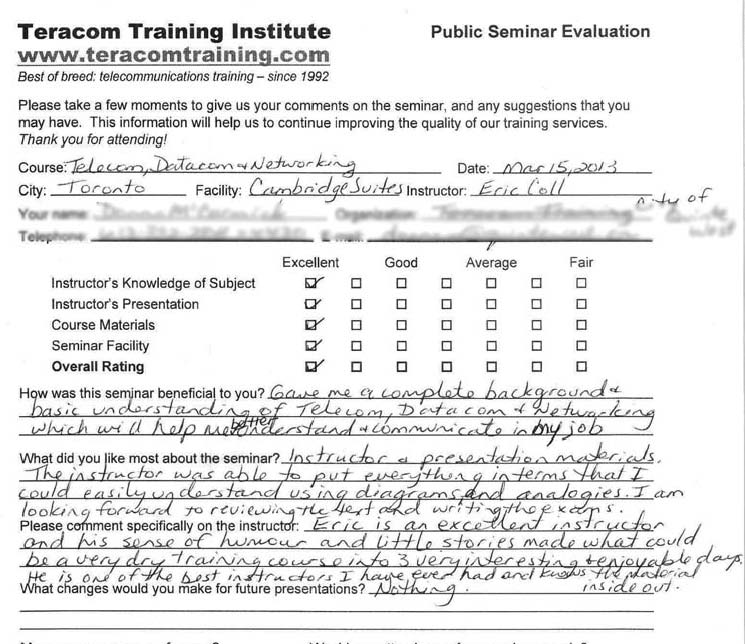 |
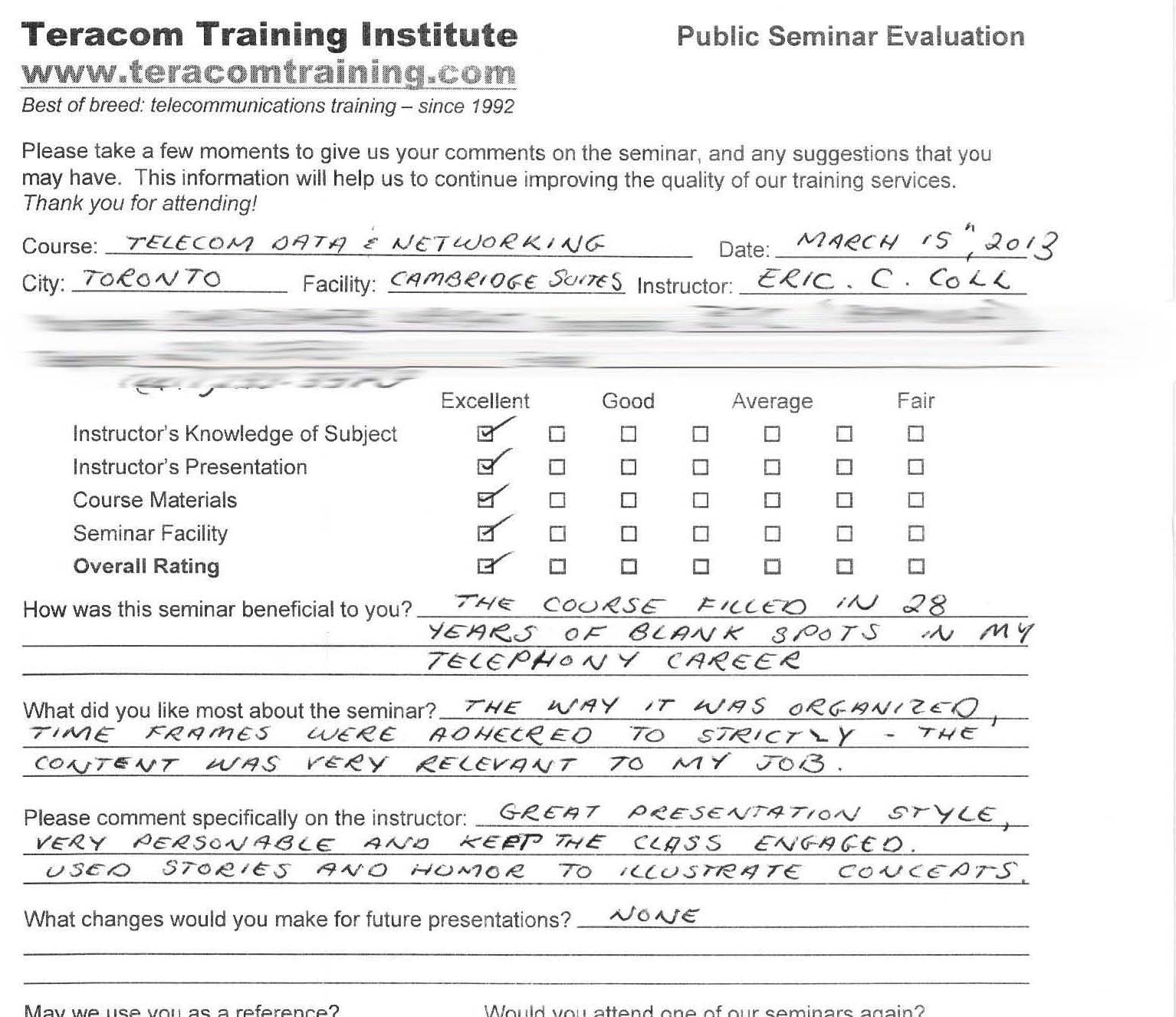 |
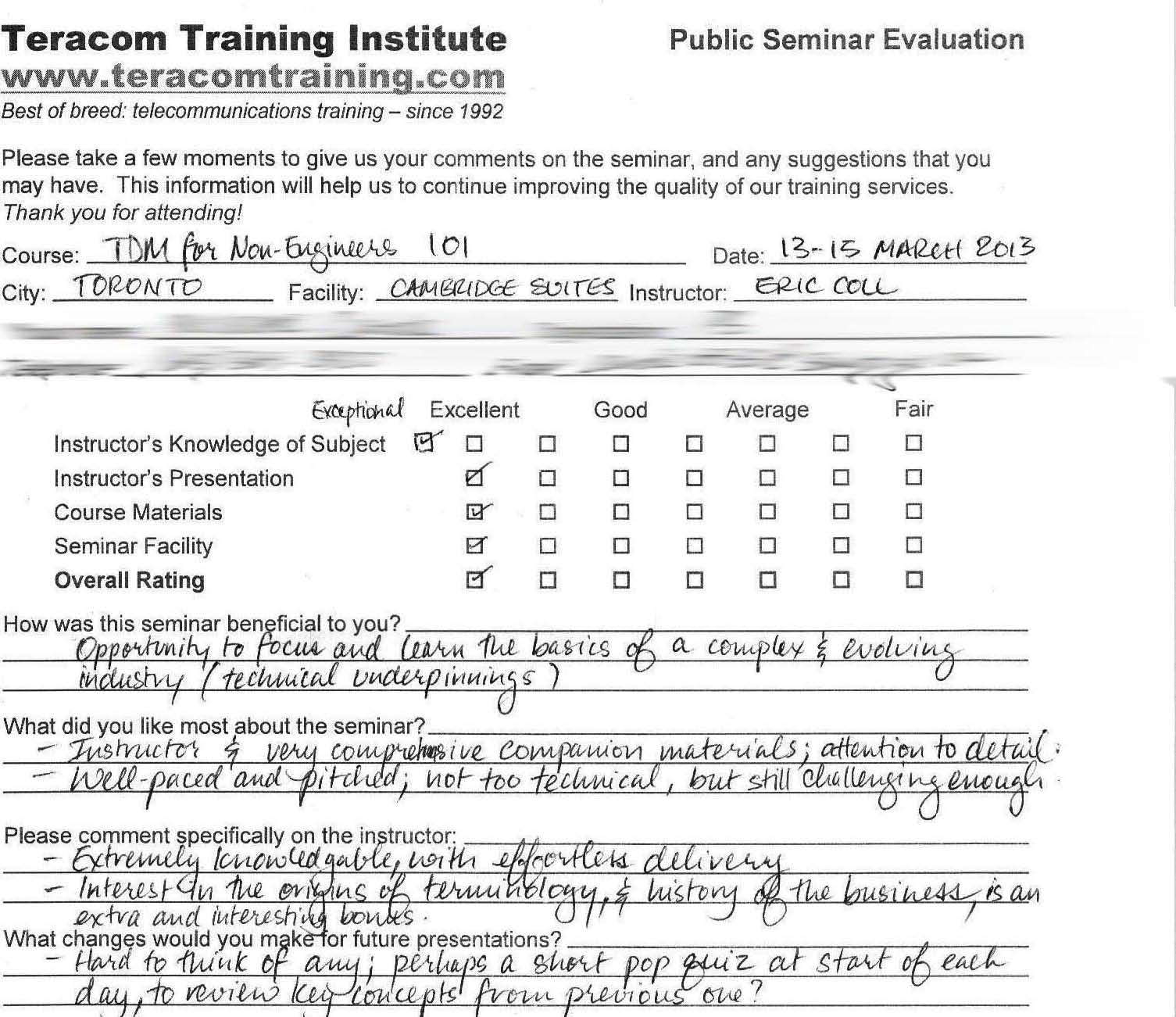 |
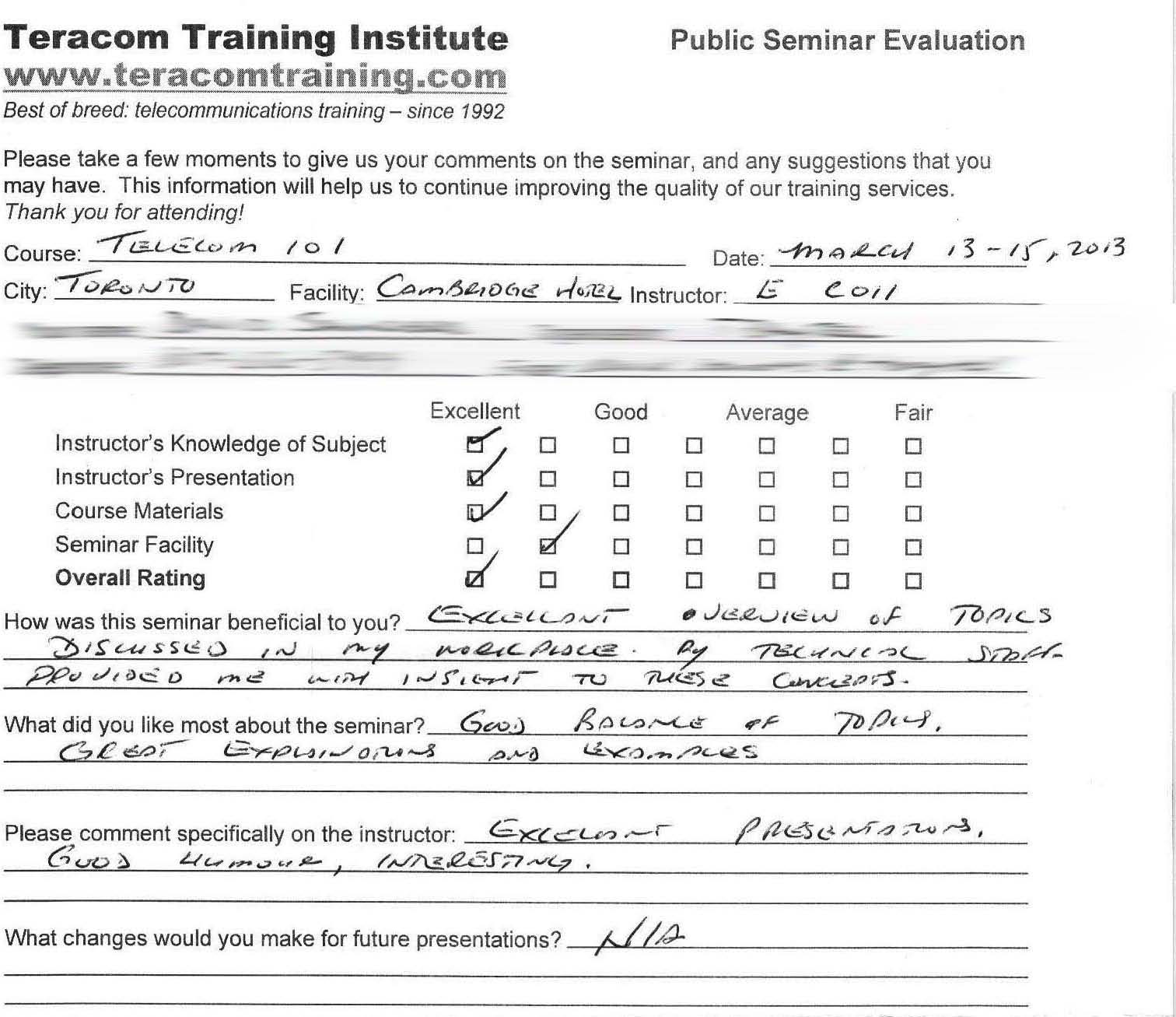 |
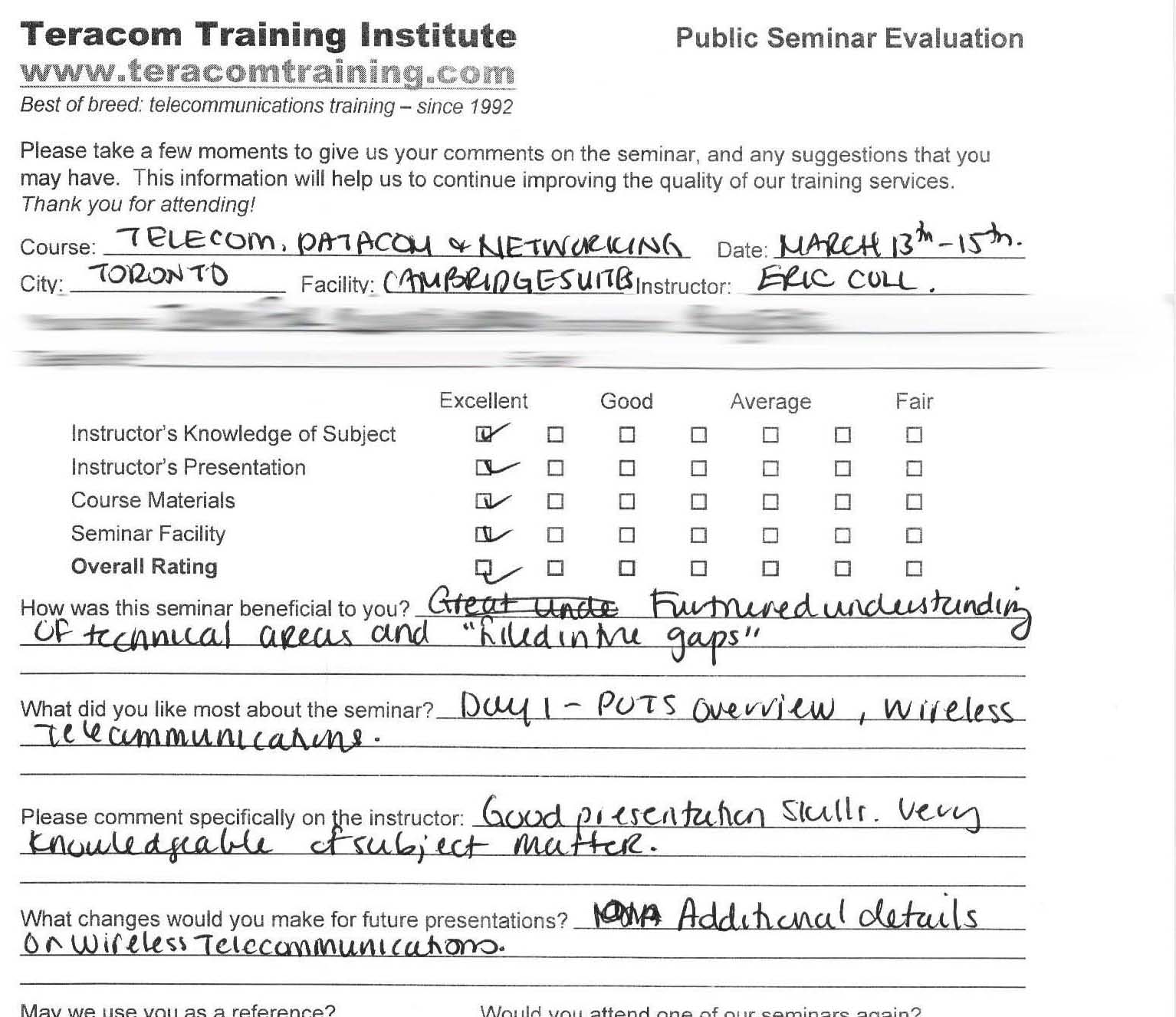 |
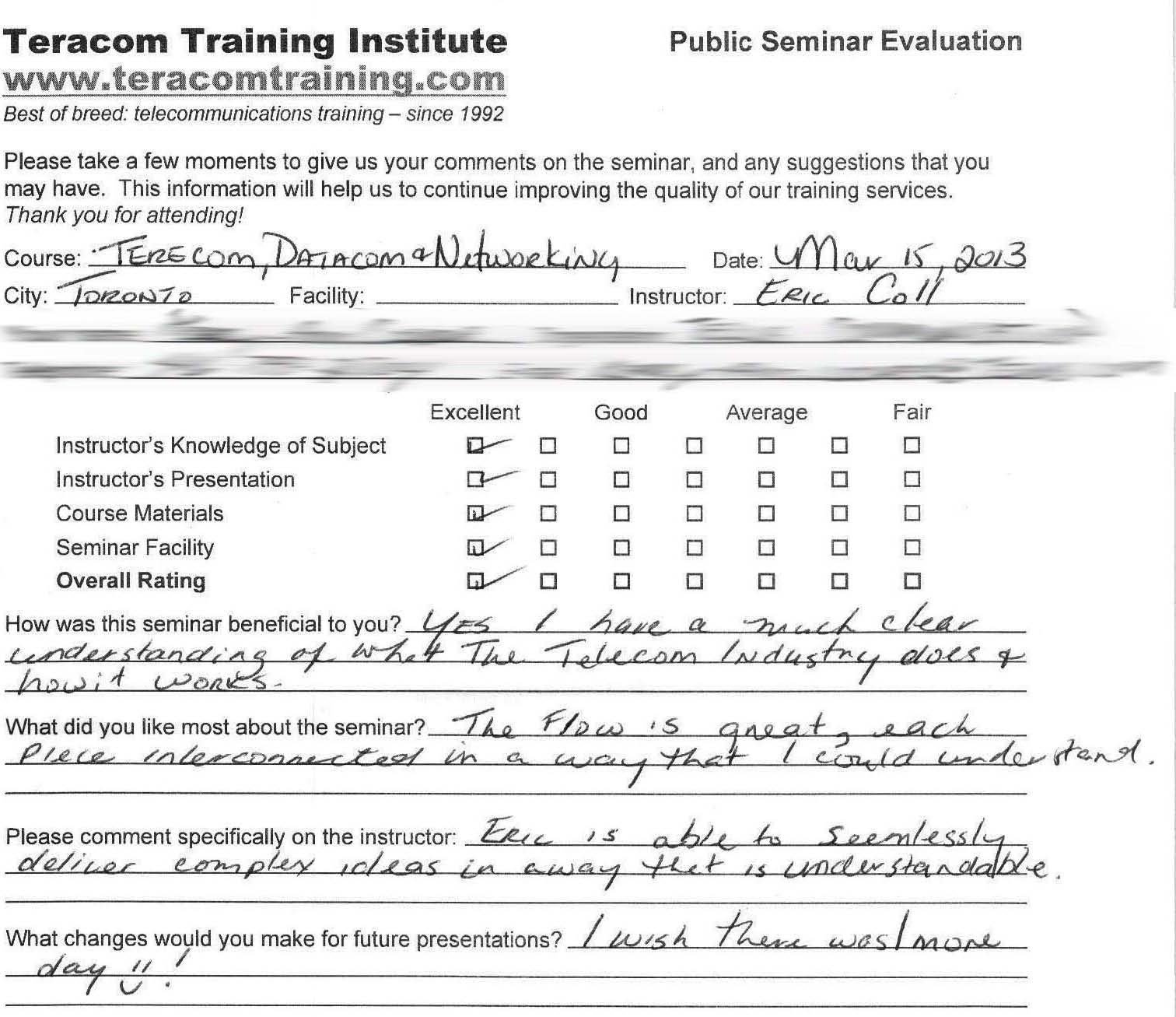 |
That's a LOT of value in quality training! more info on the CTNS Certification Package |







